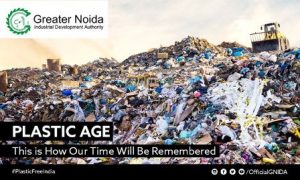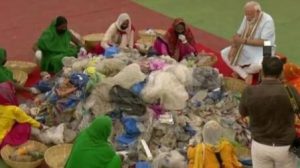Call for Single-Use Plastic Free India
According to the UN, one million plastic drinking bottles are globally purchased every minute, and people have become addicted to single-use or disposable plastic.

‘Our planet is drowning in plastic pollution’. Beat Plastic Pollution was the theme of World Environment Day, 2018, celebrated on 5 June every year, of which India was the global host. On the occasion, the then Union Environment Minister Dr Harsh Vardhan made the announcement that the country would phase-out the Single-Use Plastic (SUP) by 2022. India reiterated the same at the 4th meeting of the United Nations Environment Programme (UNEP), held at the Kenyan capital of Nairobi, from 11–15 March 2019.
Addressing the nation from the ramparts of the Red Fort on Independence Day this year, Prime Minister Modi said, ‘Can we free India from Single-Use Plastics? The time for implementing such an idea has come. May several teams be mobilized to work in this direction. Let a significant step be taken on 2 October’. The Prime Minister reiterated the same in the 14th Conference of Parties (COP14) to the United Nations Convention to Combat Desertification (UNCCD), held at Greater Noida, addressing which, he said, ‘I think the time has come for the world to say goodbye to single-use plastics’.
Stressed upon by the highest echelon of power, some announcement regarding single-use plastics (SUPs) is expected on the eve of the 150th birth anniversary of Mahatma Gandhi on 2 October this year, the day on which India will be declared Open Defecation Free (ODF).
If the strong pitch by the government is taken into account, with the aim to completely phase-out SUPs by 2022, a ban on certain items is likely.
Also Read : Environment Plastically Perishable
This is going to be a humungous task, given that India has till date not defined the term ‘Single-Use Plastics’, the term is used to loosely include items such as plastic bags, cups, water bottles, straws, etc. The United Nations, on the other hand, has defined SUPs as those plastic items which are rendered useless after being used for once and discarded thereafter.
To take the lead, several central ministries have taken steps in this direction. Food and Consumer Affairs Departments have banned the use of SUPs from 15 September onwards and so has the Ministry of Transport. Ministry of Urban Affairs was one of the first to halt the use of plastic water bottles and plastic files. The use of plastic water bottles has been stopped in the Parliament complex as well.
Besides these, as many as 18 Indian states/UTs have completely banned the use of plastic carry bags and 5 others have halted the plastic use at religious and historical places, as conveyed by the Central Pollution Control Board (CPCB) to the National Green Tribunal (NGT).

CPCB, the nodal agency responsible for pollution and related issues in India, is expected to ban 12 plastic items such as thin carry bags, straws, stirrers, disposable cutlery, ear buds, thermocol/polystyrene and small beverage bottles, among others.
Plastic Waste Management (Amendment) Rules, 2018, is already in place containing provisions such as banning plastics below the thickness of 50 microns; phasing out of multi-layered packaging that is ‘non-recyclable’, ‘non-energy recoverable’ or ‘with no alternate use’; introduced extended producer responsibility (EPR) for producers, importers and brand owners. The aforementioned rules amended similar rules introduced in 2016, which in turn replaced Plastic Waste (Management & Handling) Rules, 2011. Despite 8 years since inception, shoddy implementation and its enforcement have rendered these rules almost useless.
As per the June 2018 report in Down to Earth, 16.5 million tonnes of plastic is generated in India annually, 43 per cent of which is the SUPs which are discarded after being used once. In total, 80 per cent of plastic manufactured is discarded. As per a CPCB report for the year 2012–13, India produces 25,940 tonnes of plastic waste ‘every day’. The non-recycled waste ends up in landfills, drains and rivers, through which it enters seas and oceans, where when consumed by marine organisms, it chokes them to death. Same is the fate of birds and terrestrial animals who accidentally consume the discarded plastic.
According to a study bythe World Economic Forum, if left unchecked, oceans will have more plastic than fishes by 2050.To deal with such alarming numbers, a ban on the use of plastic might appear to be the most effective option.
The central government is expected to ban six SUP items on 2 October this year. The step is expected for a long time now but seems ill-timed at present. With uncertainty looming over which items would be banned, manufacturers aim to reduce the production of plastic, at a time when the Indian economy is witnessing the slowest growth rate in the last 6 years. With about 4 million people employed in this sector, a reduction in demand will lead to job cuts, adding to the unemployment rate, which is already highest in the last 45 years. The collection and disposal of phased out plastic items, already in circulation, will add to the government’s woes. A huge cost and effort are associated with this very step. Providing consumers with a cost-effective alternative as well as their behavioural change are the other challenges the government will face in the coming days.
Challenges don’t mean that the task is impossible. What is required is a structured response in place of an all-out ban, in which all the stakeholders, from the manufacturers to the consumers are taken into account. Here, India has a lot to learn from other countries that have handled plastic effectively.
Also Read : Revitalising Yamuna In Delhi Connecting With The People Who Matter
India’s eastern neighbour, Bangladesh was one of the first countries to ban plastics, that too as far back in 2002. The same year, Ireland came up with a ‘plastic bag tax’, employing which the consumers were made to pay for the plastic bags, the cost was so high that the use of plastic bags drastically reduced by 94 per cent in just a year. Similar steps were taken 6 years later in China in 2008 when they came up with guidelines barring vendors to give plastic bags for free. They were also directed to charge consumers for taking a plastic bag. Two years after implementation, the use of plastic bags reduced by 50 per cent in China.
Probably the best example of this issue comes from the tiny landlocked African country, Rwanda, which became plastic bags free in 2008 after it completely banned the use of non-biodegradable plastic. Strict implementation with even stricter penalties was effective enough to protect the country from the plastic menace. Scandinavian country, Sweden, adopted a different strategy of ‘No Plastic Ban, Instead More Plastic Recycling’, adoption of which has led to just 1per cent of its plastic waste ending in the country’s landfills. A structured policy coupled with effective implementation is what India requires to tackle this issue.
With a political will, when the Prime Minister takes leadership for a single-use plastic-free in the country, there is more optimism eventually for the nation to be free from the plastic menace.
(Slider Photo credit: earth.com)
